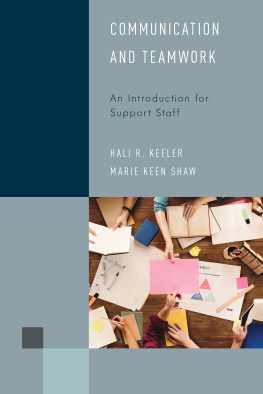Working with Library Collections
Library Support Staff Handbooks
The Library Support Staff Handbook series is designed to meet the learning needs of both students in library support staff programs and library support staff working in libraries who want to increase their knowledge and skills.
The series was designed and is edited by Hali Keeler and Marie Shaw, both of whom teach in support staff programs and have managed libraries.
The content of each volume aligns to the competencies of the required and elective courses of the American Library AssociationAllied Professional Association (ALA-APA) Library Support Staff Certification (LSSC) program. These books are both textbooks for library instructional programs and current resources for working library staff. Each book is available in both print and e-book versions.
Published books in the series include:
- Foundations of Library Services: An Introduction for Support Staff
- Library Technology and Digital Resources: An Introduction for Support Staff
- Cataloging Library Resources: An Introduction for Support Staff
- Working with Library Collections: An Introduction for Support Staff
Working with Library Collections
An Introduction for Support Staff
Hali R. Keeler
Library Support Staff Handbooks, No. 4
Rowman & Littlefield
Lanham Boulder New York London
Published by Rowman & Littlefield
A wholly owned subsidiary of The Rowman & Littlefield Publishing Group, Inc.
4501 Forbes Boulevard, Suite 200, Lanham, Maryland 20706
www.rowman.com
Unit A, Whitacre Mews, 26-34 Stannary Street, London SE11 4AB
Copyright 2017 by Rowman & Littlefield
All rights reserved. No part of this book may be reproduced in any form or by any electronic or mechanical means, including information storage and retrieval systems, without written permission from the publisher, except by a reviewer who may quote passages in a review.
British Library Cataloguing in Publication Information Available
Library of Congress Cataloging-in-Publication Data Available
LCCN 2016039955 | ISBN 9781442274884 (hardback : alk. paper) | 9781442274891 (pbk. : alk. paper) | ISBN 9781442274907 (electronic)
 The paper used in this publication meets the minimum requirements of American National Standard for Information SciencesPermanence of Paper for Printed Library Materials, ANSI/NISO Z39.48-1992.
The paper used in this publication meets the minimum requirements of American National Standard for Information SciencesPermanence of Paper for Printed Library Materials, ANSI/NISO Z39.48-1992.
Printed in the United States of America
To library support staffwe couldnt do it without you.
Contents
Preface
Working with Collections: An Introduction for Support Staff is designed as an introduction to working with library collections. It is aligned with the Collections competencies as determined by the Library Support Staff Certification (LSSC) Program of the American Library Association (ALA).
Each chapter begins with the LSSC Competencies that are to be addressed, followed by a list of topics that will be covered, as well as a glossary of key terms. Chapters are then broken into easily readable sections that relate back to these key terms. Figures, tables, and photographs are included to highlight concepts and set them apart for emphasis. The language is uncomplicated but appropriate to the material being covered. Actual library experiences are included to illustrate how these concepts work in the real world. Each chapter concludes with a summary plus questions and opportunities for extensions of learning. Readers of this text will come away with a basic knowledge of working with collections in a library.
Library support staff (LSS) are known by many names and have various levels of responsibilities. They may hold such titles as library assistants, library technical assistants, library associates, or library aides. This book can serve as a reference or refresher for them; it meets the needs of the student in a library certificate or degree program; and it can serve as a text for an instructor in such a program. This is the audience for which the book is intended.
The book contains clear wording and ample definitions, and many figures, tables, and photos help illustrate the concepts that are presented. Additionally, end-of-chapter summaries, review questions and activities, and a section of References, Suggested Readings, and Websites provides access to supplementary resources that will provide further support for instructors or to meet the individual interests of the student or the library worker.
The scope of Working with Collections: An Introduction for Support Staff assures that the reader will learn in detail about working with collections in three discrete sections. In Part I: Collections, LSS receive an overview of collections and collection development, including commonly used terminology. It covers the mission of each kind of librarypublic, academic, school, and specialand describes how the mission relates to the collection of materials in each. Also covered are the elements of the collection as well as an assessment of the community and its needs. Selection and acquisition of materials in all formats are explained, as is the management of the collection, inventory of the collection, and ultimately the deselection of items. Coverage is given to the many options for dealing with deselected materials. Part II: Tools and Technology introduces the reader to the Integrated Library System (ILS) and its modules, as well as databases and networks and their role in the collection process. Networks and the cooperative systems that link libraries are also considered for their role. The importance of collection statistics and use is covered in determining collection strengths and weaknesses. The use of statistics in creating local and state reports is a valuable inclusion, as is their use in library planning and budgets. Part III: Collection Care gives readers valuable guidance in basic materials repair, the preservation of items as well as entire collections, and very practical instructions for preparing materials in all formats for circulation and use in the library.
Working with Collections: An Introduction for Support Staff breaks new ground, as it is written expressly to align with the competencies required by the American Library Association Library Support Staff Certification Program. The authors experience teaching in a library technology program, as well as extensive research, has shown that there is a lack of appropriate instructional materials for the non-MLS student. Texts on the market are geared for the graduate level and as such are often too theoretical and technical for this level of study. The Library Support Staff Series is meant to meet this need and to provide a resource and reference for those already working in the field.
This books features will be useful to LSS in building and improving their skills and knowledge of working with collections. Textboxes provide visual emphasis on particular techniques and concepts that are important to know. Figures and photographs reinforce the step-by-step instructions and practical information. The many tables are useful resources the LSS can rely on to guide them or use as checklists as they experience these scenarios in the real world. Additionally, the chapter questions and activities provide opportunities for the LSS to review what they have learned to practice in the workplace. This book is intended to be a guide to the actual day-to-day activities that LSS will encounter.
Working with Collections: An Introduction for Support Staff came about after years of teaching LSS courses using textbooks that were designed for graduate-level study. While those books were full of good information, the students often found it difficult to wade through technical, theoretical, and complex content they would not use as support staff. Content for this book was then developed out of the authors thirty-five years of experience as a childrens librarian, library director, and adjunct professor in an LSSC-certified program and was designed to align with the ALA LSSC Competencies. The current literature, research, and hands-on practice all contributed to the content, as did the authors instructional experience with courses at Three Rivers Community College on library public services, library technical services, and management strategies.
Next page









 The paper used in this publication meets the minimum requirements of American National Standard for Information SciencesPermanence of Paper for Printed Library Materials, ANSI/NISO Z39.48-1992.
The paper used in this publication meets the minimum requirements of American National Standard for Information SciencesPermanence of Paper for Printed Library Materials, ANSI/NISO Z39.48-1992.